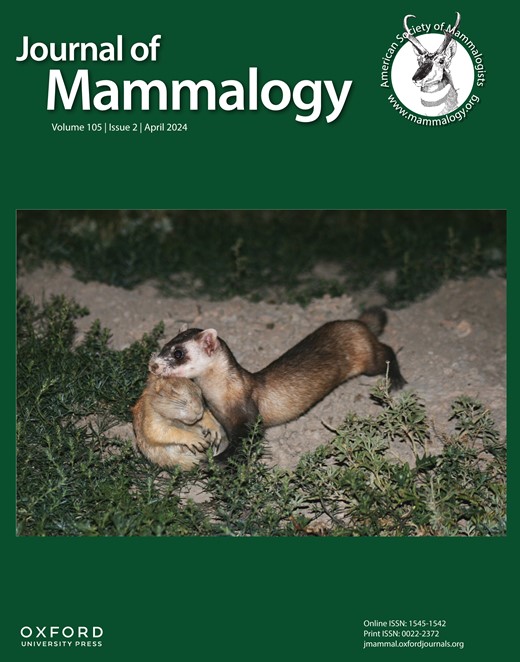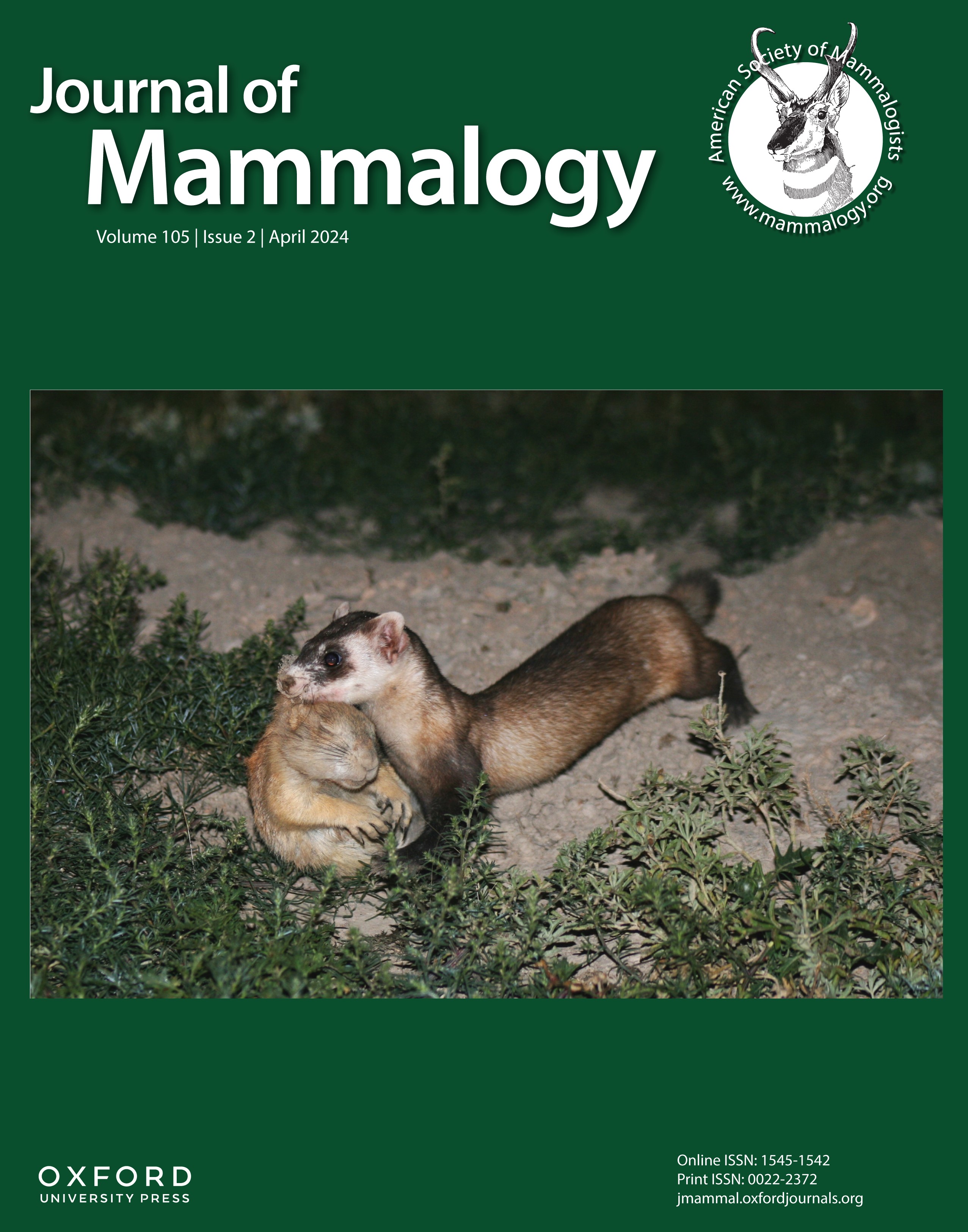
Cover image

Volume 105, Issue 2, April 2024
Research Articles
Prey selection by black-footed ferrets (Mustela nigripes): implications for intersexual resource partitioning and conservation
Black-footed ferrets specialize on prairie dogs as prey, but prairie dogs are dangerous adversaries. A prairie dog survival study in Montana and South Dakota, combined with intensive ferret monitoring, showed that female ferrets likely reduce risk by selectively hunting small (young) prairie dogs.
Beta diversity patterns in Andean rodents: current and historical factors as drivers of turnover and nestedness
Beta diversity of Andean rodents decreases latitudinally, with turnover as the dominant process and nestedness with higher contribution in the Southern Andes. Beta diversity break points partially support Andean orogenic history reflected among latitudinal segments. Figure 3 of this manuscript is recommended for promoting this research.
Species richness in Myotis (Chiroptera: Vespertilionidae): species delimitation and expanded geographic sampling reveal high Neotropical diversity
Expanded geographic sampling and analyses of genetic diversity unveil high species richness in the Neotropics, reshaping our understanding of global species diversity in myotine bats.
Unraveling the Myotis morass: ultraconserved-element analysis reveals introgression, cryptic diversity, and taxonomic trouble
Genomic tools (UCEs) place Myotis brandtii outside New World clades and illustrate the complexity of the genus. This study highlights the need to reevaluate how species are defined and delimited in Myotis and other genera with histories of rapid radiations.
Seasonal roost characteristics and fall behavior of coastal populations of Northern Myotis (Myotis septentrionalis)
We explored seasonal roost differences and fall activity patterns of coastal Northern Myotis populations occurring on 3 islands in the northeast United States. In addition to tree roosts, bats used anthropogenic roosts during both summer and fall, and the mild coastal climate allowed for extended fall activity into late November with males remaining active for longer periods than females. Northern Myotis were tracked to local hibernacula in subterranean anthropogenic structures, which may allow individuals to maintain a greater proportion of acquired fat reserves for hibernation by eliminating the need to undertake energetically costly migrations to mainland sites. Given the precipitous population declines experienced by this species in areas where white-nose syndrome is established, these island habitats may serve as important refugia to facilitate species recovery efforts.
Using PIT tags to infer bat reproductive status and parturition date: busy nights during lactation
Using an innovative method based on changes in the temporal patterns of PIT tag detections of individual female bats at maternity roosts, we estimated reproductive status and parturition date for most reproductive individuals and found that early individual arrival date and warm spring mean temperature at night led to early parturition dates.
Noninvasive EEG measurement of sleep in the family cat and comparison with the dog
In the present study, our aim was to measure sleep in family cats using a completely noninvasive electroencephalogram (EEG) measurement methodology, originally developed and validated for family dogs. We have successfully collected the sleep EEG of 12 family cats during an afternoon nap, providing a descriptive analysis of sleep characteristics in the species, as well as compared it to those acquired from dogs using the same noninvasive methodology. The sleep macrostructure showed no differences between the 2 species and the dominant power spectral densities were also similar across different sleep stages (drowsiness, non-rapid eye movement [NREM], rapid eye movement [REM]). However, the detailed analysis of power spectral densities revealed differences in all sleep stages of the 2 species (drowsiness, NREM, REM), across all frequency bands.
Diversity of MHC class II DRB alleles in the Northern chamois genus Rupicapra
In this study on the chamois genus Rupicapra, researchers explored genetic variation of the MHC class II DRB locus using next-generation sequencing. The research highlights a strong signal of positive selection at this locus, indicated by the high dN/dS ratio. The study also revealed that balancing selection maintains alleles across different chamois populations, including those that are small and isolated, emphasizing the evolutionary significance of this genetic mechanism.
A drying climate and habitat availability drive extirpations of a southward advancing ground squirrel
We resurveyed historical localities throughout the Wyoming Basin and western Colorado where Wyoming Ground Squirrel, Urocitellus elegans, specimens were collected to investigate if climate or land cover change was driving extirpations at these historically occupied sites.
Range expansion of a declining forest species, the Western Gray Squirrel (Sciurus griseus), into semiarid woodland
Species with limited ranges are declining globally. We documented a declining tree squirrel colonizing a habitat type the species did not previously occupy, possibly facilitated by climate change. This finding emphasizes the unexpected responses of species to global change.
Causes and consequences of pre-hibernation body mass in golden-mantled ground squirrels (Callospermophilus lateralis)
We used 30 years of demographic data from a high-elevation population of golden-mantled ground squirrels (Callospermophilus lateralis) to identify life history and environmental variables that influenced pre-hibernation mass in females and determine whether pre-hibernation mass influenced overwinter survival or subsequent reproduction. Our results indicate that available time appears to be the key variable for golden-mantled ground squirrels to acquire sufficient body mass to survive and reproduce, but the effects vary by age class.
Reproductive state alters vocal characteristics of female North American red squirrels (Tamiasciurus hudsonicus)
Despite no evidence that vocal cues relating to estrus are communicated in the North American Red Squirrel, we found that female vocal characteristics showed significant variation related to both reproductive state and body mass. To our knowledge, this is the first evidence of vocal changes associated with pregnancy in a nonhuman mammal.
Three new shrews (Soricidae: Crocidura) from West Sumatra, Indonesia: elevational and morphological divergence in syntopic sister taxa
The number of shrew species in Southeast Asia has historically been undercounted, in part due to the cryptic nature of these tiny mammals. Here, we describe 3 new species from West Sumatra, Indonesia. Two of these species only occur on a single mountain and are sister taxa; however, 1 is nearly 2 times the size of the other, in addition to other morphological differences. We discuss how syntopic, sister species of shrews that differ in size and morphology have now been identified on mountains in Sumatra, Java, and Borneo.
Effects of burn severity and postfire salvage logging on carnivore communities in montane forests
We examined carnivore habitat use 6 to 13 years after wildfire and postfire salvage logging in western North America. Disturbance severity strongly influenced wildlife activity on burned landscapes; forest-specialist and generalist carnivores selected different postfire habitats.
Landscape and farm environmental structure determinants of small mammal assemblages in agroecosystems of central Argentina
Our research addresses the influence of landscape and farm structure on small mammals. Our results show multiscale determinants on small mammal assemblages and population abundances. Our findings reveal associations, linking water bodies, vegetation cover, and landscape structure to assemblage composition and abundance. Species richness increased with landscape heterogeneity.
Determining abundance predictors of the European Hare (Lepus europaeus), a global invader in southeastern Brazil
The invasive European Hare is more likely to attain higher local abundance in areas that combine diverse land cover types, including sugarcane but little native savanna. Abundance estimates were low and did not vary dramatically among sites, suggesting European Hare have not yet attained high density in southeastern Brazil. Monitoring hare densities in agricultural landscapes with diverse land covers, containing sugarcane and little native savanna coverage, is advisable.
How does an urban landscape influence spatiotemporal ecology of South American coatis (Nasua nasua)?
This study explores coati space use and activity patterns in an urban environment. In this scenario, coatis select forested areas and reduce their home range, but do not change their circadian activity.


